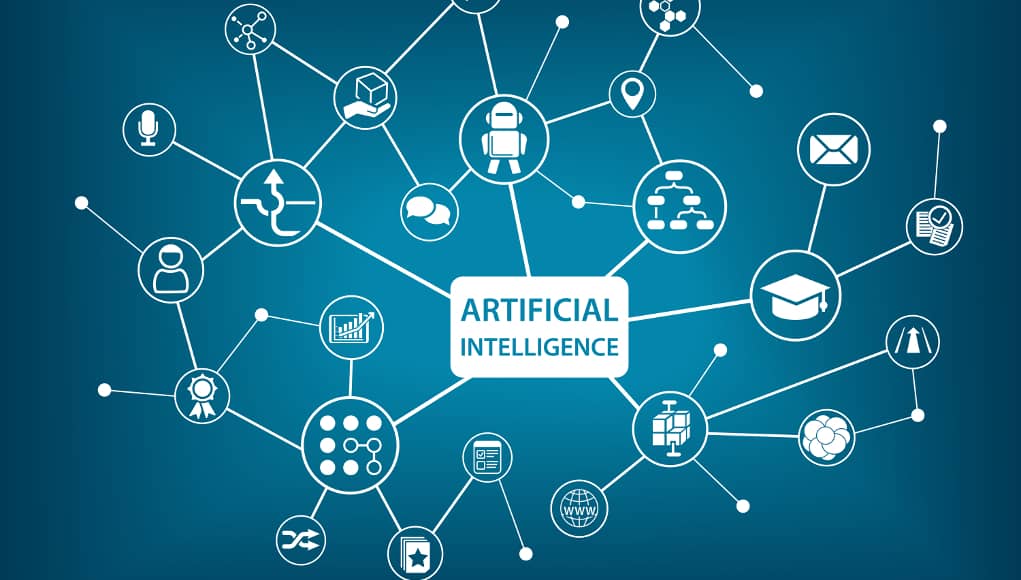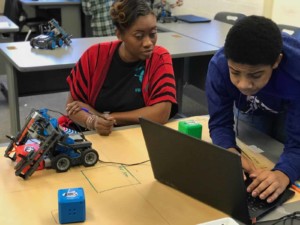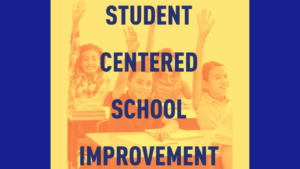32 Ways AI is Improving Education

In the last few years, machine learning applications have quietly entered every aspect of life: social media to speech recognition, radiology to retail, warfare to writing articles, coding to customer service, robotics to route optimization.
During the 40 year information age, we told computers what to do. With advances in artificial intelligence, particularly machine learning, and faster processing chips we can feed computers giant data sets and they can (in narrow slivers) draw some inferences on their own. As we reported in Ask About AI, the rise of code that learns marks the beginning of a new era of augmented intelligence. It’s a great opportunity for us to expand access to a great education and for young people to make a big contribution.
Given the importance of relationships in human development, AI will augment rather than replace the work of educators in many ways. We’ll all have to get better at collaborating with teams that include smart machines. In other professions, augmentation will lead to automation with the potential for significant dislocation. Amazon’s workforce, for example, is about 20% robots.
Machine learning is beginning to improve student learning and provide better support for teachers and learners. Following is a quick list of a couple dozen applications that are (or soon will be) making good use of machine learning to support better education.
Improving Learning
1. Early learning. Kidaptive is an adaptive learning platform with games and toys for small children. Osmo is an interactive game that combines online and hands-on learning.
2. Adaptive learning. Curriculum Associates i-Ready is widely used adaptive reading and math software. Last week The Rise Fund made a huge investment in DreamBox and Imagine Learning acquired nonprofit adaptive math software Reasoning Mind.
3. Course materials. Premium content and curated open content providers are increasingly using machine learning to serve up the next best lesson. Startups like Content Technologies Inc. are using machine learning to automate the process.
4. Online learning. Scaled postsecondary providers like Coursera, Udacity, and edX are using machine learning to improve targeting, courses, and support services.
5. Language learning. Language learning apps for formal and informal use (Duolingo, Babbel, Rosetta Stone) take advantage of better matching and translation services. VIPKID recently raised another $500 million to more fully incorporate the benefits of machine learning.
6. Writing. Feedback and scoring systems powered by machine learning like Grammarly, Turnitin, WriteLab (acquired by Chegg), PEG Writing, and Write to Learn are becoming more widely used.
7. Coding and maker. LittleBits and Modular Robotics teach the basics of robotics. Tynker and CodeHS teach coding. All are increasingly AI-informed.
8. Test Prep. Study and test prep tools like Quizlet, Kaplan, Magoosh and Mumbai-based Toppr are getting smarter fast.
9. Scheduling. Abl Schools is an example of a next-gen school scheduling. With schools like Purdue Polytech moving to individual student schedules, expect smarter scheduling tools soon.
10. Exploration. More kids are getting a chance to learn and create in augmented and virtual reality. Machine learning will continue to improve the VR experience in many ways including gesture and voice recognition, image rendering and better collaborative experiences.
11. Assistive tech. Dozens of features benefiting special needs learners have improved in the last two years including voice recognition, text to voice, and text modification.
12. Assessment. Machine learning is improving assessment in many ways including adaptive testing (NWEA), faster grading (GradeScope), tracking steps in problem-solving (Thinkster) and monitoring student progress including hard to measure skills (Panorama Education). It will also be key to interoperability and combining multiple sources of formative assessment (see #15).
13. Diagnosis. AI is rapidly improving in the diagnosis of medical conditions, vision problems, and learning differences.
14. Analytics. Powering early warning and nudge systems, analytics platforms including BrightBytes, Civitas Learning, Acrobatiq aare already widely used in higher education and are gaining traction in K-12.
15. Guidance systems. Talent platforms like LinkedIn and Ziprecruiter help match employers and high potential candidates. Localized information by job cluster will become more available on high school platforms like Naviance and WorkKeys with links to rapid pathways to employment.
16. Competency management. Super gradebooks will combine assessment information from multiple sources and help teachers make mastery judgements signaled with badges or microcredentials.
17. Learner profiles. Interoperability to support competency management (#15) will be aided by large scale comparisons of comprehensive profiles (think expanded gradebooks and portfolios). Distributed ledgers will become a portable directory of expanded records. Human reviewers will use transcript length summaries for the foreseeable future but will increasingly be augmented by machine learning tools that will review much larger profiles–both submitted and scraped. (Listen to an interview with Matt Pittinsky from Parchment for more).
18. Learning management systems. Learning platforms like Canvas from Instruction, D2L, and AltSchool make limited but growing use of machine learning. There are a few adaptive LMS like Fishtree and Realizeit are used mostly in career ed. As learner profiles (#16) more platforms will add recommendation engines and personalized pathways.
Progress is likely to be even faster in the corporate LMS market. And we’ll start to see more cross over benefit as groups like NAF adopt corporate platforms like SuccessFactors from SAP.
19. Experience management. As learning becomes more distributed and as competency systems improve, systems will be developed that source, schedule, and invoice learning experiences (i.e., LRNG meets AirBNB).
20. Mentoring. Connecting industry mentors to students at the right time for the right reasons (what Patty Alper calls project-based mentoring). While Nepris Learning and Educurious do some of this today, imagine a supercharged version with contribution incentives (mostly likely to emerge associate with college alumni associations).
21. Recruiting and onboarding. Machine learning is widely used in corporate recruiting and onboarding and it’s coming to education. Frontline Education is a big HR rollup building a smart platform to improve the efficiency of recruiting, matching and onboarding.
22. Staff scheduling and substitute management. To handle increasingly complex staffing plans that support personalized and competency-based learning, Frontline and others are building better smart scheduling solutions.
23. Professional learning: Adopting blended and personalized learning strategies, new learning platforms for educators mix open and proprietary content, offer microcredentials. In the near future, these platforms will be adaptive with personalized recommendations (perhaps offered by schools of education and platform partners).
Improving Supports
24. Transportation: bus scheduling just got easier with AI-powered mobile apps like Creatrix. In less than ten years districts will be incorporating pool transportation and autonomous vehicles into pupil transportation schemes.
25. Maintenance. Dude Solutions brought the power of cloud software to building and ground maintenance. It’s getting easier to monitor equipment and employee productivity and compare to industry benchmarks. Schools can gain some control over the time (e.g., when to mow the lawn) and services.
26. Facilities management. Smart building management software helps manage HVAC, lighting and security.
27. Nutrition. The Mayo Clinic created an AI program called FEED (Feeding Effectively Using Electronic Data) to focus on the safety and quality of patients receiving nutrition support. In Finland, there are five agile piloting sprints to use smart tools to improve nutrition and wellness.
28. Purchasing. A Deloitte survey of purchasing officers found that 88% believe automation and robotics will impact procurement within five years. New purchasing platforms will create efficiency, independence and support accurate tracking.
29. Finance. In the business world, according to Accenture, “automation, minibots, machine learning and adaptive intelligence are becoming part of the finance team at lightning speed.” Monthly closing and expense management will be simplified. Where school board members have questions, an AI chatbot will provide answers.
30. Cybersecurity. Security professionals are expected to spend more on AI-powered tools. A Cisco report said AI should be able to learn how to automatically detect unusual patterns in encrypted web traffic and Internet of things (IoT) environments.
31. Safety and Security. AI is increasingly being used even identify patterns in student language or behavior that could foreshadow school violence. A Parkland high school student created the #NeverAgainTech project that she hopes will result in an AI-driven compilation and analysis of a wide range of data related to school shootings.
32. School management. With a growing number of microschools in the west (see CottageClass and Acton Academy) and low-cost private schools in Africa and India, there is growing interest in school management platforms that include recruitment, student information, attendance, and payment (see Bridge International).
For as far as we can see, sustained relationships with teachers that develop powerful learning experiences will continue to be the most important factor in education. But AI just hit the accelerator on almost every tool used in schools. The opportunity to help young people learn will continue to improve every month.
For more, see:
- Ask About AI: The Future of Work and Learning
- Coming This Fall to Montour School District: America’s First Public School AI Program
- Building the Cognitive Muscles to Thrive in the Automation Age
- Sharing: The New Superpower
Stay in-the-know with all things EdTech and innovations in learning by signing up to receive the weekly Smart Update.








Tom Vander Ark
3 additions from Alina (Olteanu) von Davier, Senior Vice President at ACTNext by @ACT
33. Automatic Content Generation (ACG). We started with automatically generated multiple-choice items for low-stakes tests based on psychometric models; now we are generating complex content materials using computational models from the AI toolbox fused with psychometric models.
34. Collaboration. Facilitation of collaboration in virtual environments via platforms and measurement of collaborative skills via multimodal analytics (again through a fusion of data-driven computational models and psychometrics)
35. Data management in education: edge computing and datacubes for collecting, storing and archiving continuous streams of data. parallel computing for estimating the complex model
Diana Thenerd
As the technology is improving continuously, a considerable number of study apps are hitting the market that are making studying both easier and more entertaining. Using these apps students can focus more on their studies. Multiple apps can really contribute to your academic performance.
Anas Aldeeb
There should be more robots in the future because it will be better if there is much more robots. Robots are good because they do jobs for humans. Robots should be very common to sell so life becomes much more easier. Robots have better memories than humans beings. People should start increasing the number of robots.
gkanswers
Thanks for giving this information.
Reeii Education
You have written a beautiful article, which has some good points like yes we all know that technology is increasing day by day, and the idea of AI with education is a booster to that which is helping the students and will help in future also.